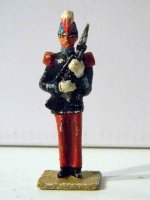I'm not sure zinc is used in any alloys that figure makers use to cast. For one thing, I think zinc may melt at higher temperatures than the alloys of tin, antimony, bismuth and lead in various proportions used to cast toy soldiers and model figures. In fact, some of the molds I have for casting are made of a zinc alloy. If they were to melt at the melting point of the tin-lead alloys I use, they'd be useless.
To the question of whether zinc rot is similar to lead rot, it probably is, in that it sounds like another case of oxidation of the metal, under the right conditions.
As far as oak is concerned in all of this, it's thought that the tannic acid in the oak triggers the oxidation, but that is still not proven. Also, for that to happen, the oak would have to be unsealed or unvarnished, to allow changes in humidity and air pressure to leach the tannic acid into the air, a process that is similar to ageing wine and spirits in oak barrels. Oak doesn't give off rays. And some collectors have figures stored in oak cabinets, and have never had any issues, while others have collections stored in other types of cabinets, in which some figures begin to oxidize but no others do. As a starting point, the alloy used to cast the figure is key.
Prost!
Brad
 Zinc pest is a diecast collectors nightmare especially collectors of model cars, aircraft and even model trains.
Zinc pest is a diecast collectors nightmare especially collectors of model cars, aircraft and even model trains. {eek3} But is their many occurences with Toy Soldiers. I am a little of a Toy Soldier Collector newbie, so please
{eek3} But is their many occurences with Toy Soldiers. I am a little of a Toy Soldier Collector newbie, so please So are the generally Ok due to their different metal make/up:redface: Zinc Pest ~ destructive, intercrystalline corrosion process of zinc alloys of poor purity..
So are the generally Ok due to their different metal make/up:redface: Zinc Pest ~ destructive, intercrystalline corrosion process of zinc alloys of poor purity..


